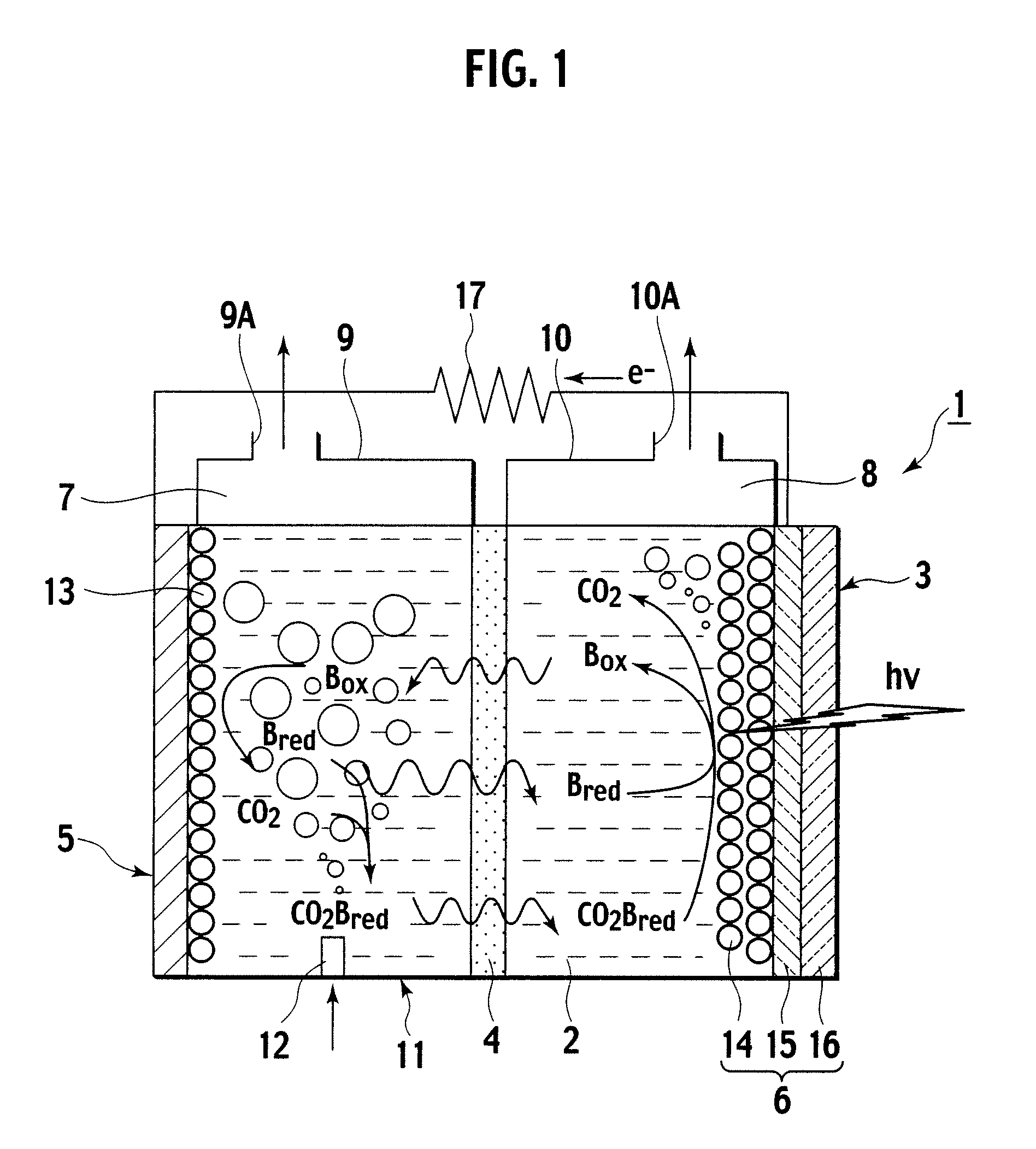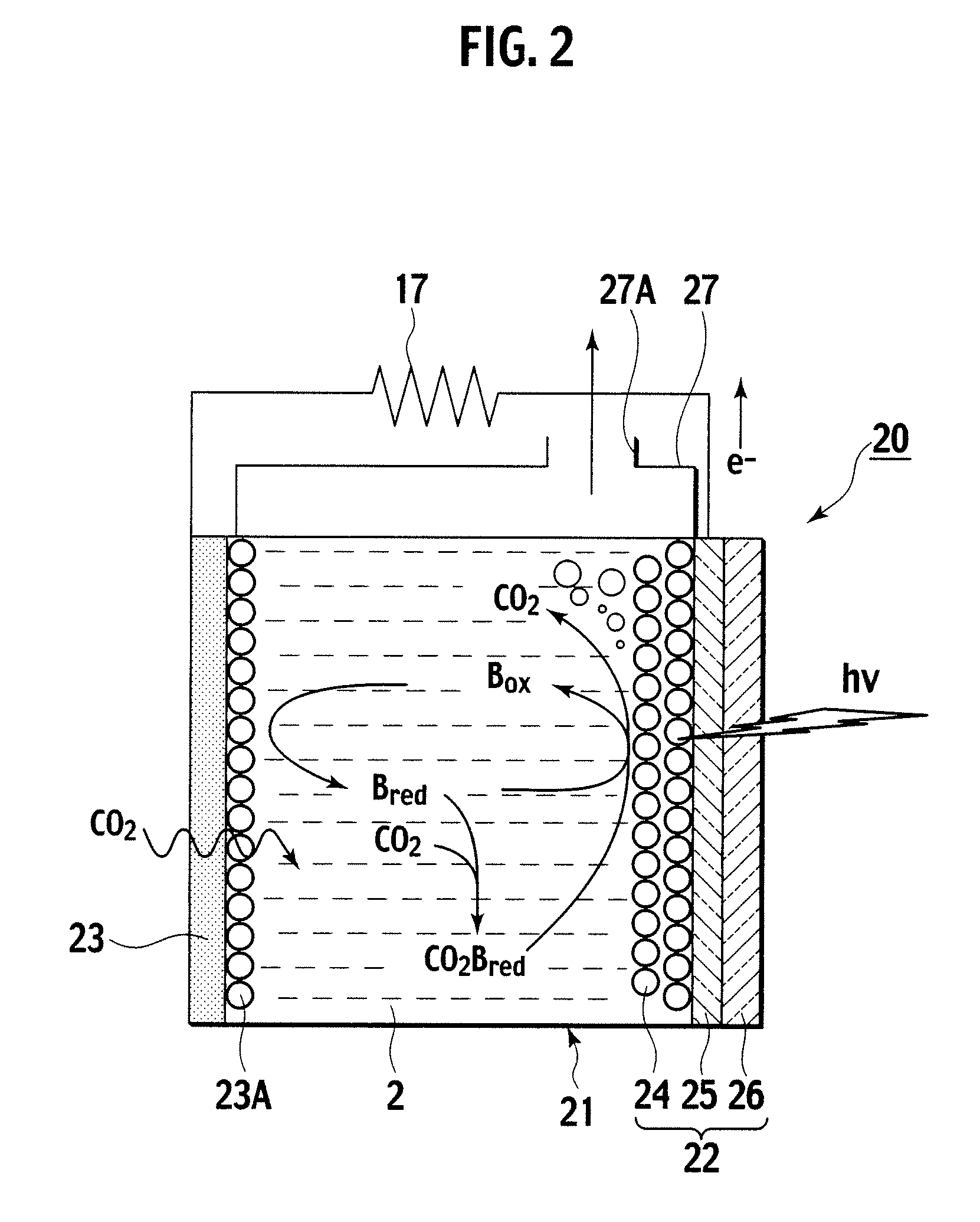Photoelectrochemical Cell
a photoelectrochemical and cell technology, applied in the field of photoelectrochemical cells, can solve the problems high cost, and obtaining power to be consumed, and achieves the effects of reducing the concentration of carbon dioxide, and reducing the current efficiency of supplied power
- Summary
- Abstract
- Description
- Claims
- Application Information
AI Technical Summary
Benefits of technology
Problems solved by technology
Method used
Image
Examples
first embodiment
[0039]Description is now made of a photoelectrochemical cell according to a first embodiment of the invention, with reference made to FIG. 1. As shown in FIG. 1, the photoelectrochemical cell 1 according to this embodiment includes an electrolyte container 3 containing an ionic liquid 2 as an electrolyte, and a partitioning membrane 4 dividing an interior of the electrolyte container 3 into two to be a left and a right.
[0040]The electrolyte container 3 has opposing sidewalls with the partitioning membrane 4 in between, of which one is made as a carbon electrode 5, and the other as an optical electrode 6.
[0041]Further, the electrolyte container 3 is divided into a CO2 capturing chamber 7 and a CO2 releasing chamber 8, with the partitioning membrane 4 in between. Then, over the CO2 capturing chamber 7, an upper wall portion 9 is formed, and an emission port 9A is formed in the upper wall portion 9. Over the CO2 releasing chamber 8, an upper wall portion 10 is formed, and a CO2 take-ou...
second embodiment
[0064]Description is now made of a photoelectrochemical cell according to a second embodiment of the invention, with reference made to FIG. 2 to FIG. 4.
[0065]As shown in FIG. 2, the photoelectrochemical cell 20 according to this embodiment includes an electrolyte container 21, an optical electrode 22, and a porous carbon electrode 23. The optical electrode 22 and the porous carbon electrode 23 concurrently serve as sidewalls of the electrolyte container 21 at mutually opposing positions. This embodiment is not configured with a partitioning membrane as in the photoelectrochemical cell 1 according to the first embodiment described.
[0066]The porous carbon electrode 23, made of carbon of a porous structure, is set to be impermeant to an ionic liquid 2, but permeable simply for gaseous bodies. This embodiment is configured to take in carbon dioxide of exhaust gases into ionic liquid 2, not by a bubbling of exhaust gases introduced into the ionic liquid 2, but by exposing an outside of p...
third embodiment
[0074]Description is now made of a photoelectrochemical cell according to a third embodiment of the invention, with reference made to FIG. 5 and FIG. 6. According to this embodiment, the photoelectrochemical cell 30 is configured to be the photoelectrochemical cell 20 according to the second embodiment, as this is modified to have a porous carbon electrode formed cylindrical, and adapted to pass exhaust gases through a cylindrical hollow of the cylindrical porous carbon electrode.
[0075]As shown in FIG. 5 and FIG. 6, the photoelectrochemical cell 30 according to this embodiment includes an electrolyte container 31, an optical electrode 32 constituting part of a sidewall of the electrolyte container 31, and a porous carbon electrode 33 formed cylindrical so as to vertically extend through and within the electrolyte container 31. The porous carbon electrode 33 is disposed in a position set off from the optical electrode 32. This embodiment is not configured with a partitioning membrane...
PUM
| Property | Measurement | Unit |
|---|---|---|
| bonding forces | aaaaa | aaaaa |
| bonding force | aaaaa | aaaaa |
| transparent | aaaaa | aaaaa |
Abstract
Description
Claims
Application Information
 Login to View More
Login to View More - R&D
- Intellectual Property
- Life Sciences
- Materials
- Tech Scout
- Unparalleled Data Quality
- Higher Quality Content
- 60% Fewer Hallucinations
Browse by: Latest US Patents, China's latest patents, Technical Efficacy Thesaurus, Application Domain, Technology Topic, Popular Technical Reports.
© 2025 PatSnap. All rights reserved.Legal|Privacy policy|Modern Slavery Act Transparency Statement|Sitemap|About US| Contact US: help@patsnap.com



